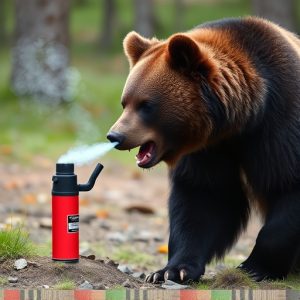Bear Attack Protection: Strategies & Laws for National Park Safety
Understanding bear behavior is crucial for visitor safety in national parks, where rangers educate o…….
Understanding bear behavior is crucial for visitor safety in national parks, where rangers educate on hunting and feeding patterns. Bear spray, a non-lethal deterrent, is commonly used but its legality varies; adherence to local laws is essential. Proper precautions like distance, noise, and gear (including bear spray) are emphasized. Beyond basic skills, knowledge of animal behaviors and safe practices enhance safety. After a bear attack, staying calm and seeking medical help is vital. Sharing experiences with park officials contributes to improving safety measures regarding bear spray laws and prevention strategies.
“In the vast wilderness, encountering a bear can be an awe-inspiring yet potentially dangerous experience. With growing human activity in national parks, understanding and preparing for bear attacks is paramount. This comprehensive guide explores essential strategies for survival, focusing on bear behavior, prevention techniques, and post-attack recovery. From deciphering bear habitat to navigating legal aspects of bear spray use in national parks, we equip readers with the knowledge to enhance their safety in these breathtaking yet unpredictable landscapes.”
- Understanding Bear Behavior and Their Habitat: A National Park Perspective
- The Role of Bear Spray: Effectiveness and Legal Considerations
- Staying Safe in Wilderness Areas: Additional Prevention Strategies
- Post-Attack Survival and Recovery: What to Do If the Unforeseen Happens
Understanding Bear Behavior and Their Habitat: A National Park Perspective
In national parks across the globe, understanding bear behavior and their habitat is paramount for ensuring visitor safety. Bears are wild animals with complex hunting and feeding patterns that vary depending on the season and available food sources. While they generally avoid human interaction, encounters can occur, especially when humans encroach upon their territory or food sources. National park rangers play a crucial role in educating visitors about bear habits, such as when and where bears are most active, and how to properly store food to prevent attracting them.
Bear spray laws vary across national parks, but they are generally implemented to discourage aggressive behavior from bears. This non-lethal deterrent is effective because it can create a barrier between humans and bears, providing time for individuals to retreat safely. However, it’s essential to note that bear spray should be used as a last resort and proper knowledge of bear behavior is critical to avoiding dangerous situations altogether. Rangers emphasize the importance of maintaining distance, making noise to signal presence, and carrying essential survival gear, including bear spray, when exploring bear habitat areas within national parks.
The Role of Bear Spray: Effectiveness and Legal Considerations
Bear spray is a popular choice for wilderness survivalists and outdoor enthusiasts navigating bear-inhabited areas, such as national parks. Its effectiveness in deterring bears has been well-documented, particularly in preventing attack and injury. When used correctly, bear spray creates a barrier of capsaicin, the active ingredient, which irritates a bear’s eyes and respiratory system, causing it to retreat. This tool is especially valuable in close-quarters encounters where other methods may not be feasible.
However, the legality of carrying bear spray varies across jurisdictions, particularly within national parks. Bear spray laws are designed to balance the rights of recreational users with the preservation of wildlife and public safety. It’s crucial for visitors to familiarize themselves with the specific rules and regulations governing bear spray possession and use in their intended destinations, such as national parks, to ensure compliance and contribute to a safe outdoor experience.
Staying Safe in Wilderness Areas: Additional Prevention Strategies
When venturing into wilderness areas, especially national parks known for their diverse wildlife, it’s crucial to go beyond basic survival skills and implement preventative measures against potential threats, including bear attacks. Beyond carrying a reliable bear spray – whose laws vary by location but are often required in national parks – understanding local behaviors and habitats can significantly boost your safety. Researching the specific species prevalent in your destination and their feeding patterns can help you anticipate encounters.
Adopting safe practices while camping or hiking, such as securely storing food in designated bear-resistant containers and making noise to deter bears from approaching unexpectedly, are additional prevention strategies. Staying on marked trails and avoiding isolated areas during peak hunting or mating seasons further reduces the risk of unwelcome interactions with these powerful animals.
Post-Attack Survival and Recovery: What to Do If the Unforeseen Happens
In the event of a bear attack, your immediate survival instincts will kick in, but what happens afterward is crucial for recovery and future prevention. Post-attack survival requires staying calm and assessing your injuries. If possible, seek medical attention as soon as you’re out of immediate danger. Many national parks have specific protocols and resources in place to help manage such incidents, including emergency contacts and first aid stations.
Bear spray laws vary across different national parks, but its possession is often recommended for visitors due to the potential risk of bear encounters. Understanding local regulations and knowing how to use bear spray effectively can significantly increase your safety during outdoor activities. Remember, recovery involves both physical healing and psychological processing. Share your experience with park officials to help improve their safety measures and educate others on bear attack prevention strategies.
In wilderness areas, especially within National Parks, understanding bear behavior and employing effective protection methods are paramount. While no method guarantees complete immunity from bear attacks, combining knowledge with tools like bear spray (ensuring compliance with local laws, including those in National Parks) significantly improves safety. Additionally, adhering to prevention strategies and being prepared for the rare occurrence of an attack can enhance your survival chances. Remember, awareness, preparation, and quick thinking are key when navigating these wild landscapes.


